AUDI S8 2008 Owners Manual
Manufacturer: AUDI, Model Year: 2008, Model line: S8, Model: AUDI S8 2008Pages: 404, PDF Size: 52.7 MB
Page 131 of 404
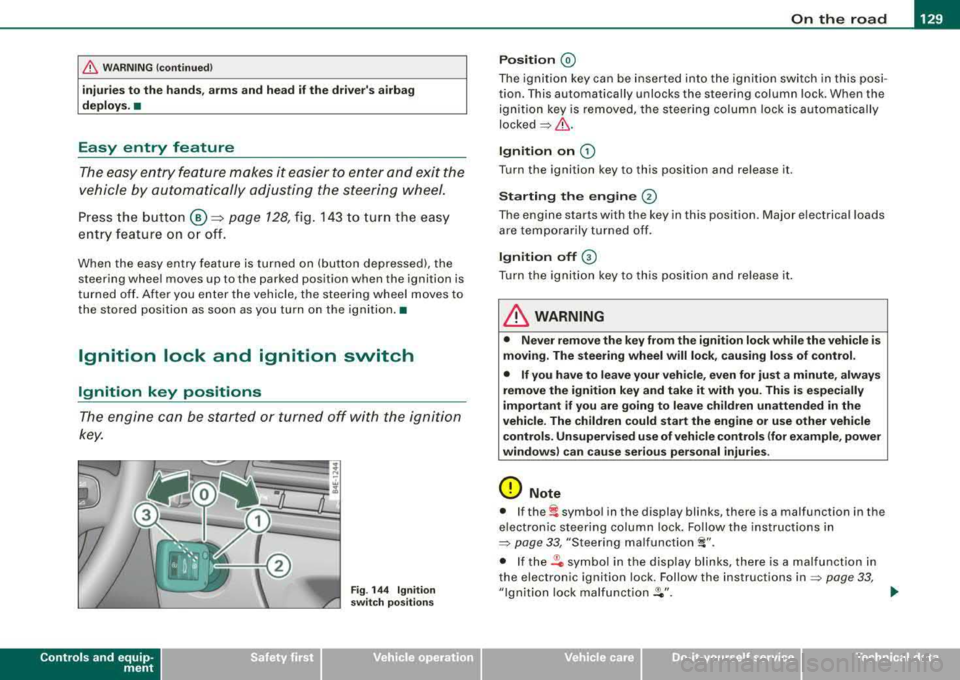
___________________________________________________ O_ n_ t_h _e_ r_o _a_ d _ ___.111111
fl::. WARN ING (c o ntinue d)
injurie s to the hands, arm s and head if the driv er's a irbag
deplo ys.•
Easy entry feature
The easy entry feature makes it easier to enter and exit the
vehicle by automatically adjusting the steering wheel.
Press the button @ ::::> page 128, fig . 143 to turn the easy
entry feature on or off.
When the easy entry feature is tu rned on (bu tton depressed), the
steering wheel moves up to the parked position when the ignition is
turned off. After you en ter the vehicle, the steer ing wheel moves to
the stored position as soon as you turn on the ignition. •
Ignition lock and ignition switch
Ignition key positions
The engine can be started or turned off with the ignition
key.
Contro ls a nd eq uip
ment
F ig . 14 4 Ignit ion
sw itch po sitio ns
P os it ion @
The ignition key can be inserted into the ignition switch in this posi
tion. This automatically unlocks the steering column lock. When the ignition key is removed, the stee ring co lumn lock is automatically
locked
=> fl::. .
Ignition on G)
Turn the ignition key to this position and re lease it.
Starting the engin e @
The engine starts with the key in this position . Major electrical loads
are tempo rar ily turned off.
Ign ition off G)
Turn the ignition key to this position and re lease it .
& WARNING
• Never remo ve the key from th e ign ition lock while the ve h icle i s
mo ving . The stee ring wheel will lo ck, c au sing loss of control.
• If you have to leave your veh icle, even for ju st a minute , al ways
remove the ignition key and take it with you. Thi s is esp eciall y
important if you are going to lea ve ch ildren unatten ded in the
vehi cle . The ch ildren co uld start the eng ine or u se other vehicle
c ontrol s. Un super vis ed u se of veh icle control s (for e xam ple , po wer
windows ) can cause seriou s personal inj uries .
0 Note
• I f the~ symbo l in the display blinks, there is a malfunction in the
e lectron ic steering column lock. Fo llow the instructions in
=> page 33 , "Steering malfunction i".
• If the .Pc symbol in the display b links, there is a malfunct ion in
the electronic ignition lock. Follow the instructions
in => page 33,
"Ignition lock malfunct ion .Pe" . ..
Vehicle care I I irechnical data
Page 132 of 404
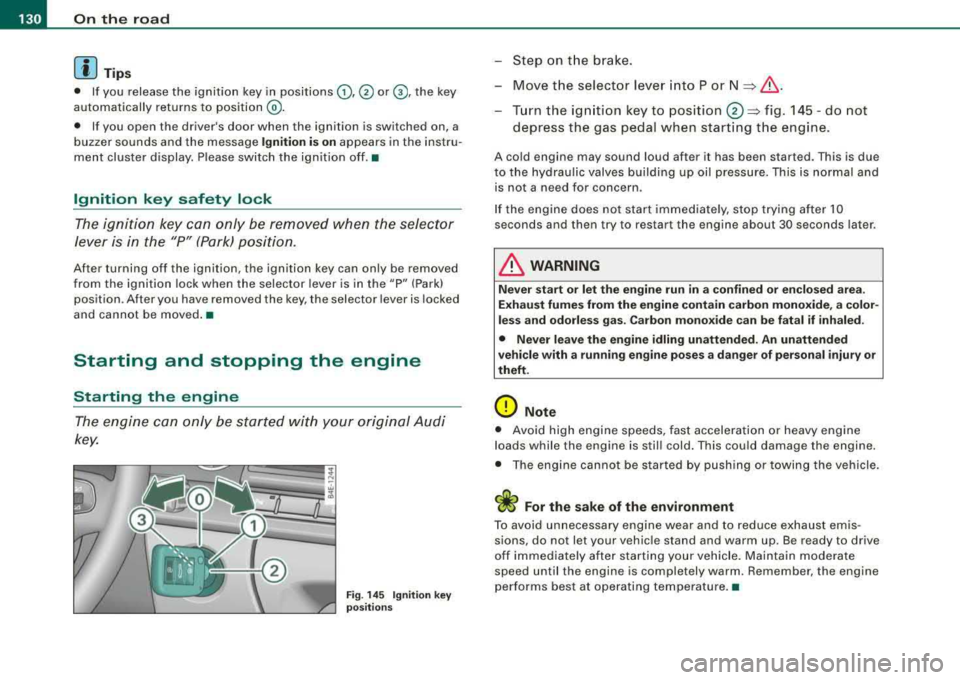
___ O_ n_ t_h _e_ r_o _ a_ d ____________________________________________________ _
[ i J Tips
• If you release the ignition key in positions G) ,@ or G) , the key
automatically returns to pos ition @.
• If you open the driver 's door when the ignition is switched on , a
buzzer sounds and the message
Ignition is on appears in the instru
ment cluster display. Please switch the ignition off .•
Ignition key safety lock
The igni tio n key can only be re move d when the selector
lever is in the
"P" (P ark) posi tion.
After turning off the ignition , the igni tion key can only be removed
from the ignition lock when the selec tor lever is in the
"P" (Park)
position . Af ter you have removed the key , the selector lever is locked
and cannot be moved .•
Starting and stopping the engine
Starting the engine
The engine ca n only be st arted with y our or iginal A udi
key.
Fig . 14 5 Ignit ion key
po sitions
-St ep o n the brake.
- Move t he selector lever into P or
N => &, .
-Turn the ign ition key to position 0 => fig . 14 5 -do not
depress the gas pedal when start ing t he engine .
A cold engine may sound loud after it has be en started. This is due
to the hydrau lic valves building up oil pressure. This is normal and
is not a n eed fo r concern .
I f the engine does not start immediately, stop trying after 10
seconds and then try to restart the engine about 30 seconds later .
& WARNING
Never start or let the engine run in a confined or en clo sed are a.
Exhaust fumes from the engine contain carbon monoxide, a color
less and odorle ss gas . Carbon mono xide can be fatal if inhaled.
• Never leave the engine idling unattended. An unattended
vehicle with a running engine po ses a dange r of person al injury or
theft.
0 Note
• Avo id high e ngine speeds, fast accelerati on or heavy eng ine
loads while the engine is still cold. This could damage the engine.
• The eng ine ca nnot be s tarted by push ing or towi ng the ve hicle.
sions, do not let your vehic le stand and warm up. Be ready to drive
off im mediately afte r starting your vehicle . Maintain modera te
speed until the engine is completely warm . Remember , the engine
performs best at operating temperature. •
Page 133 of 404

On the road -
-----------------'
Stopping the engine
-Turn the ignition key to position®~ page 130, fig. 145.
& WARNING
• Never turn off the engine until the vehicle has come to a
complete stop.
• The brake booster and servotronic only work when the engine
is running. With the ignition turned off, you have to apply more
force when steering or braking. Since you cannot steer and stop normally, this can lead to accidents and serious injuries .
• The radiator fan can continue to run for up to 10 minutes even
after you have turned off the engine and removed the ignition key.
The radiator fan can also turn on again if the engine coolant heats
up because of intense sunlight or heat build-up in the engine
compartment.
0 Note
Do not stop the engine immediately after hard or extended driving.
Keep the engine running for approximately two minutes to prevent
excessive heat build-up.•
Contro ls a nd eq uip
ment
Starting and stopping the engine
using the Advanced Key
A pp lies to veh ic les: with Advanced Key
Starting the engine using the [ START] button
Using this button, you can switch on the ignition and start
the engine.
0
0
Fig . 146 Advanced
Key: START button
The [ START] button has a two position feature. ~ fig. 146.
Switching on the ignition
-Press the [START] button to the first position. Only the
ig nition switches on .
Starting the engine
-Depress the foot brake.
- Move the selector lever into the P or N position
~ &.
- Press the [ START] button to the second position. The
engine starts.
Vehicle care I I irechnical data
Page 134 of 404
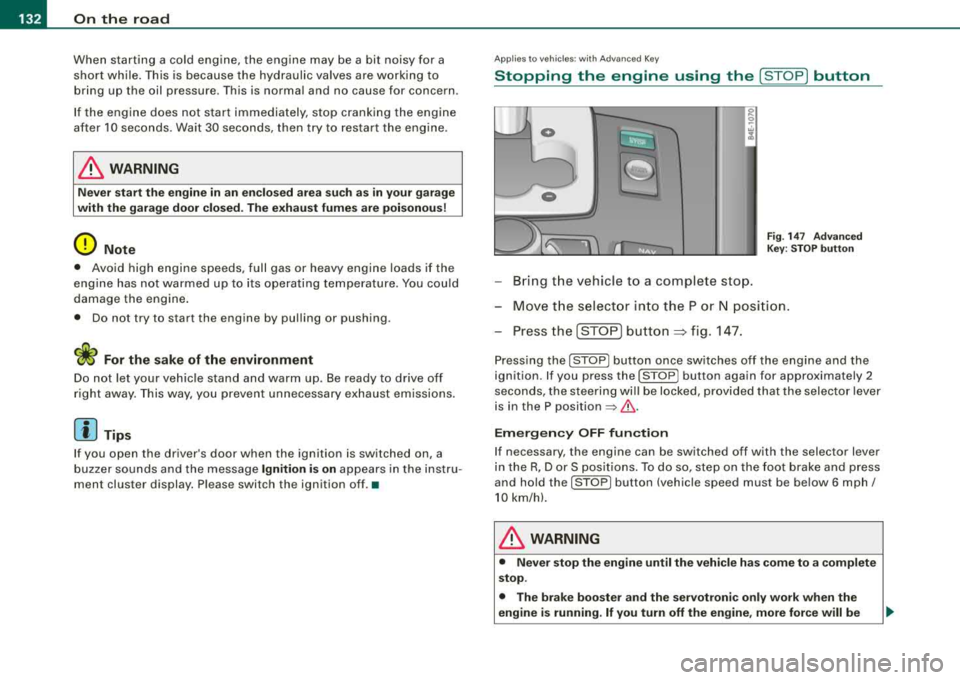
-
On the roa d
----------------
When starting a cold engine, the engine may be a bi t noisy for a
shor t w hile. This is because the hydraulic valves are working to
bring up the oil pressure . This is norma l and no cause for concern .
If the engine does not start immediately, stop cranking the engine
after 10 seconds . Wa it 30 seconds, t hen try to restart the eng ine.
& WARNING
Ne ver sta rt the engine in an en clo sed area su ch a s in your garage
with the garage door clo sed . The exhau st fumes are poi sonous!
0 Note
• Avoid high engine speeds, full gas or heavy engine loads if the
eng ine has not warmed up to its operating temperature . You cou ld
damage the engine.
• Do not try to start the engine by pu lling or pushing .
~ For the sake of the environment
Do not let your veh ic le stand and warm up . Be ready to drive off
right away. T his way, you prevent unnecessary exhaust emissions.
[ i ] Tip s
If you open th e driver 's door when the ignition is switched on , a
buzzer sounds and the message
Ignition i s on appears in the instru
ment cluster display. P lease switch the ign ition off .•
A pp lies to vehicles: w it h Ad vanced Key
Stopping the engine using the [S TO P] button
0
0
- Bring t he vehicle to a complete stop.
Fi g. 14 7 Advan ced
Ke y: S TOP button
-Mov e th e s elect or in to the P or N posi tion .
- Press the [STO P]
button => fig. 14 7.
Press ing the [ STOP) butto n once sw itches o ff the engi ne and the
ignition . If you press the [STOP] button again for approximately 2
seconds, the steeri ng wi ll be locked, provided that the selector lever
is in the P position
=> & .
Em ergen cy OFF fun ction
If necessary, the engine can be switched off with the selector lever
in the R, Dor S pos it io ns. To do so, step on the foot brake and press
and ho ld the [S T O P] button (vehic le speed must be be low 6 mph/
10 km/h).
& WARNING
• Never stop the engine until the vehi cle h as c ome to a complete
stop .
• The br ake boo ster and the servotroni c onl y w ork when the
engine is running . If you turn off the engine , more force will be
Page 135 of 404
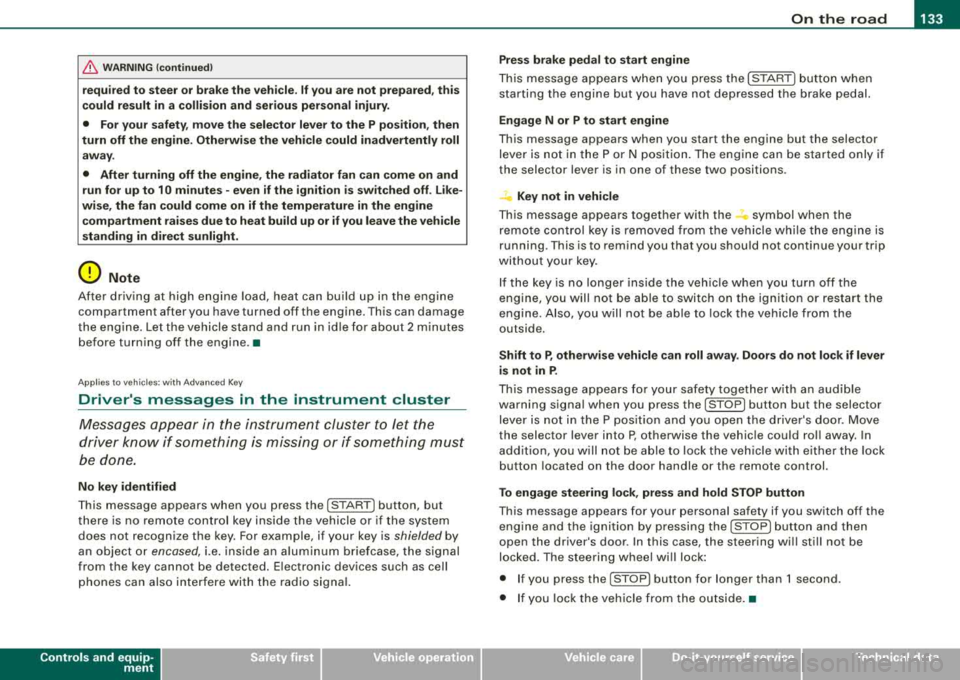
On the road -----------------
& W AR NIN G (c ontinu ed )
re qu ir e d to ste er or br ake the vehicle . If you are n ot prep ared , this
c ould r esult in a colli sion and serious per sonal injur y.
• For y our safet y, move the sele cto r lever to the P po sition , then
turn off the engine. Oth erw ise the vehi cle could inad vertently roll
away.
• After tu rning off the engin e, the r adi ato r fa n ca n co me on and
ru n for up to 10 minute s
-even if the ignition is sw itched off . Like
wise , the fan could com e on if the temper ature in the engine
c omp artm ent r ais e s du e to he at build up or if you le ave the vehicle
s tanding in direc t sunligh t.
0 Note
After driving at high engine load, heat can bu ild up in the engine
compartment after you have turned off the engine. This can damage
t he engine . Let the veh icle stand and run in id le for about 2 minutes
before turning off the engine .•
Applies to vehicles: with Advanced Key
Driver's messages in the instrument cluster
Messages appear in the instrument cluster to let the
driver know if something is missing or if some thing must
be done.
No ke y identified
This message appears when you press the [ START ] button, but
t here is no remote control key insi de the vehicle or i f the system
does not recognize the key . For example, if your key is
shielded by
an object or
encased, i.e . ins ide an a lum in um br iefcase, the sig nal
from the key cannot be detected. E lectronic devices such as cell
phones can also interfere with t he rad io signa l.
Controls and equip
ment P
re ss bra ke pedal to start engine
This message appears when you press the [ S TART] button when
starting the engine but you have not depressed the brake pedal.
En gage N or P to start engine
This message appears when you start the engine but the selector
lever is not in t he P or
N pos ition. The e ng ine can be started o nly if
the selector lever is in one of these two positions .
-.?. Key not in vehicle
This message appears together with the -:?e symbol when the
remote con trol key is removed from t he ve hicle whi le the engine is
running . This is to remind you that you should not continue your trip
without you r key .
I f the key is no longer inside the veh ic le when you turn o ff the
engine, you will not be able to switch on the ignition or restart the
eng ine. Also, you w ill not be ab le to loc k the veh icle from the
outside.
S hift t o P, other wise vehi cle ca n roll away. Doors d o not lo ck if le ver
i s not in P.
This message appears for your safety together wit h an aud ib le
warning signa l when you press the [S TO P] button but the selector
lever is not in the P posit ion and you open the driver's door. Move
the selector lever into P, otherwise the vehic le could rol l away. In
addit ion, you will not be able to lock the vehicle with either the lock
button located on the door handle or the remote control.
To engag e steering lo ck, pre ss a nd hold S TOP button
This message appears for your personal safety if you switch off the
engine and the ignition by pressing the [ S TOP ] button and then
open the driver's door. In this case, the steering will sti ll not be
locked. The stee ring wheel wi ll lock :
• If you press the [ STOP] button for longer than 1 second.
• If you lock the vehicle fr om the outside .•
Page 136 of 404
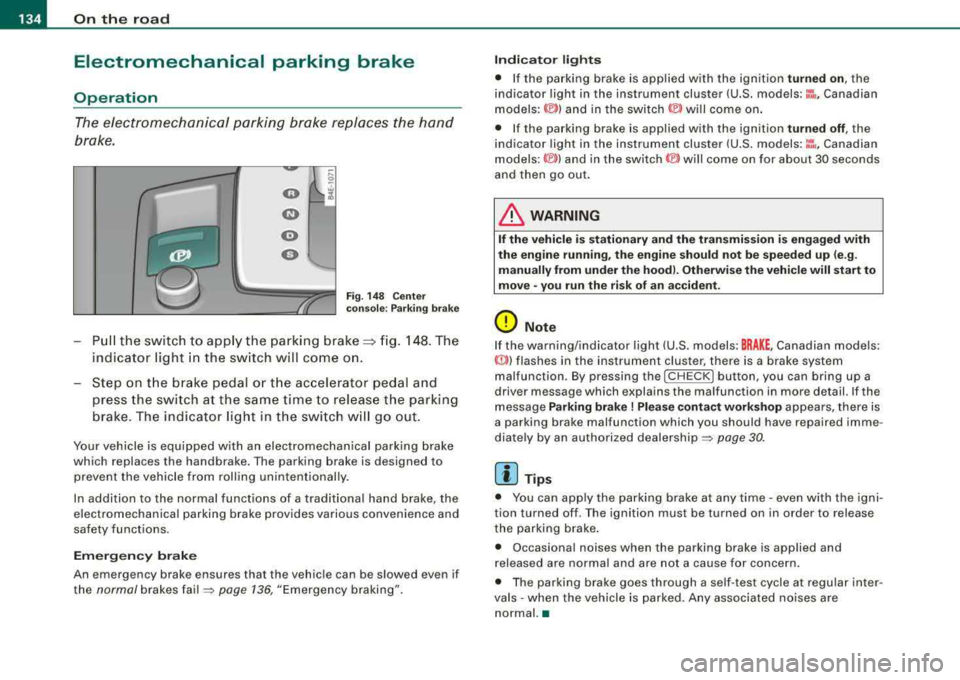
___ O_ n_t_ h_ e_ ro_ a_d __________________________________________________ _
Electromechanical parking brake
Operation
The electromechani ca l parking brake replaces the hand
brake.
F ig. 148 C enter
co nso le: P arki ng b ra ke
Pu ll the switch to app ly the parking brake==> fig. 148. The
indicator light in the sw itch will come on.
Step on t he brake pedal o r th e acce lerator pedal and
press th e switch at the s am e time to rel eas e the parking
brake . The indicator light in t he switch w ill go out .
Your vehicle is equ ipped w ith an electromechanical parking brake
which replaces the handbrake . The parking brake is designed to
prevent the vehicle from rolling unintentionally .
In addition to the norma l functions of a trad itiona l hand brake, the
e lectromechanical parking brake provides various convenience and
safety functions.
Em erg ency brake
An emergency brake ensures that the vehicle can be slowed even if
the
normal brakes fa il=> page 136, "Emergency braking".
Indi cat or light s
• If the pa rking brake is app lied with the ignition turned on , the
indicator light in the instrument cluster (U.S. models:
::i , Canadian
models: ©) and in the switch © will come on .
• If the parking brake is applied with the ignition
tu rn ed off , the
indicator light in the instrument cluster (U .S .
models :~~ . Canadian
models :(®) ) and in the
switch (®) will come on for about 30 seconds
and then go out.
& WARNING
I f the vehicle i s stati onary and the transmis sion i s engaged with
the eng ine runnin g, the engine should n ot b e speeded up (e .g .
manu ally from under the ho od). Otherw ise th e vehi cle w ill start to
mo ve
-you r un the ris k of an ac cident .
0 Note
If the warning/indicator light (U .S . models: BRAKE , Canadian models:
«D>) flashes in the instrument cluster, there is a brake system
malfunction . By pressing the
I CH ECK] button , you can bring up a
driver message which explains the malfunction in more detail. If the
message
Parking brake! Plea se conta ct w ork shop appears, there is
a parking brake malfunction which you should have repaired imme
diate ly by an authorized dealership =>
page 30.
[ i] Tips
• You can app ly the parking brake at any time -even with the igni
tion turned off . T he ignition must be turned on in order to release
the parking brake.
• Occasional noises when the parking brake is applied and
released are norma l and are not a cause for concern .
• The parking brake goes through a se lf -test cycle at regular inter
va ls
-when the vehicle is parked. Any associated no ises are
normal. •
Page 137 of 404
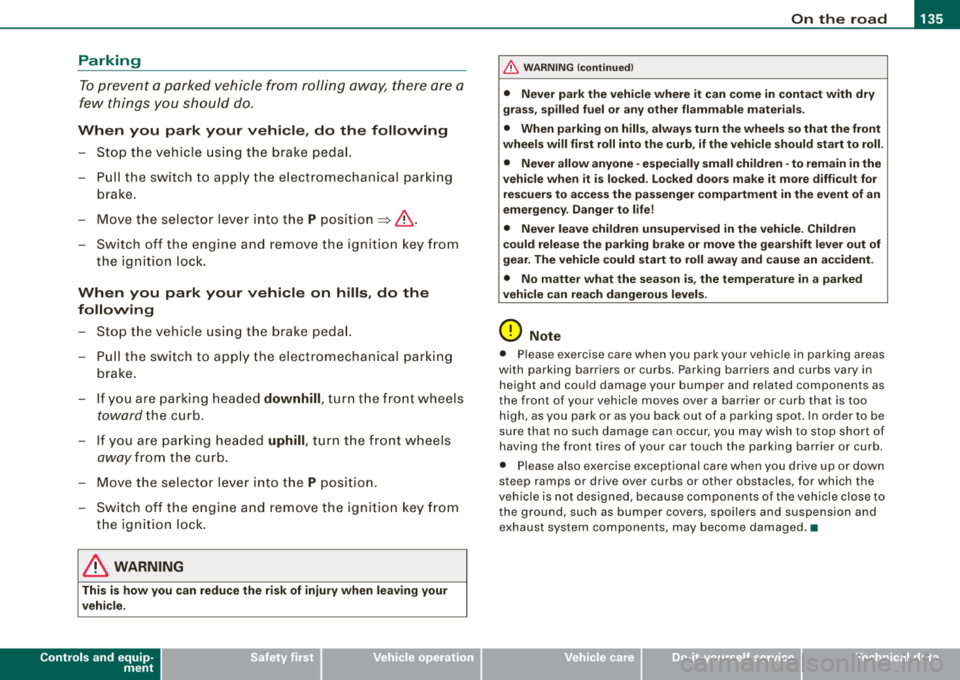
On the road -----------------
Parking
To prevent a parked vehicle from rolling away, there are a
few things you should do.
When you park your vehicle, do the following
- Stop the vehicle using the brake pedal.
- Pull the switch to apply the electromechanical parking
brake.
- Move the selector lever into the
P position => &.
- Switch off the engine and remove the ignition key from
the ignition lock.
When you park your vehicle on hills, do the
following
- Stop the vehicle using the brake pedal.
- Pull the switch to apply the electromechanical parking
brake.
- If you are parking headed
downhill, turn the front wheels
toward the curb.
- If you are parking headed
uphill, turn the front wheels
awayfrom the curb.
- Move the selector lever into the
P position.
- Switch off the engine and remove the ignition key from
the ignition lock.
& WARNING
This is how you can reduce the risk of injury when leaving your
vehicle.
Controls and equip ment
&, WARNING (continued)
• Never park the vehicle where it can come in contact with dry
grass, spilled fuel or any other flammable materials.
• When parking on hills, always turn the wheels so that the front
wheels will first roll into the curb, if the vehicle should start to roll.
• Never allow anyone -especially small children -to remain
in the
vehicle when it is locked. Locked doors make it more difficult for
rescuers to access the passenger compartment in the event of an
emergency. Danger to life!
• Never leave children unsupervised in the vehicle. Children
could release the parking brake or move the gearshift lever out of
gear. The vehicle could start to roll away and cause an accident.
• No matter what the season is, the temperature in a parked
vehicle can reach dangerous levels.
0 Note
• Please exercise care when you park your vehicle in parking areas
with parking barriers or curbs . Parking barriers and curbs vary in
height and could damage your bumper and related components as
the front of your vehicle moves over a barrier or curb that is too high, as you park or as you back out of a parking spot. In order to be
sure that no such damage can occur, you may wish to stop short of
having the front tires of your car touch the parking barrier or curb.
• Please also exercise exceptional care when you drive up or down
steep ramps or drive over curbs or other obstacles, for which the
vehicle is not designed , because components of the vehicle close to
the ground, such as bumper covers, spoilers and suspension and
exhaust system components, may become damaged. •
Page 138 of 404
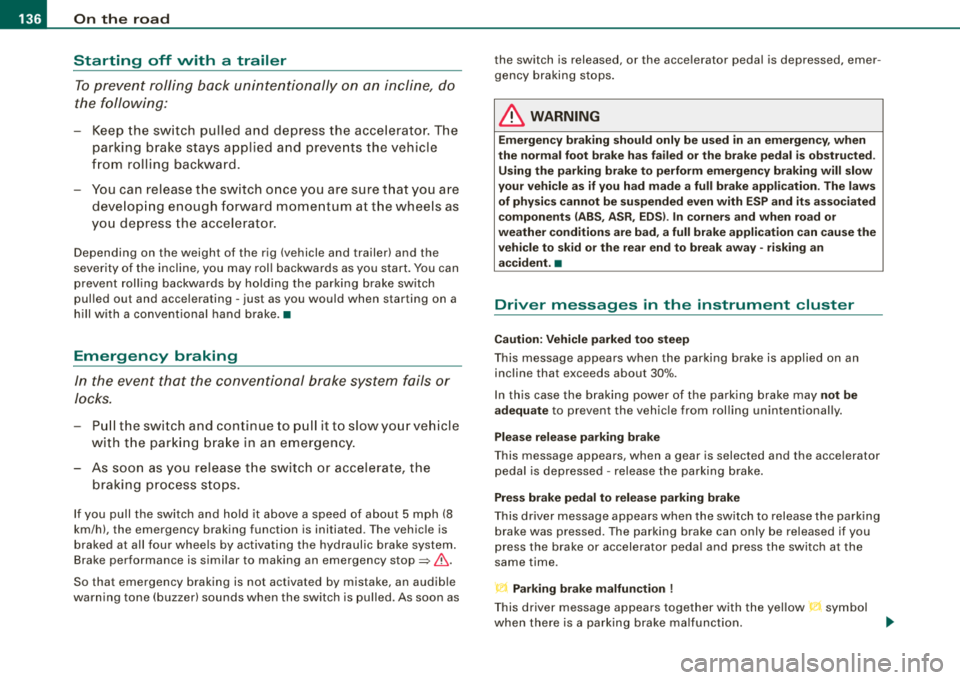
___ o_ n_ t_
h _e _ ro_ a_d __________________________________________________ _
Starting off with a trailer To prevent rolling back unintentionally on an incline, do
the following:
- Keep the switch pulled and depress the accelerator. The
parking brake stays applied and prevents the vehicle
from rolling backward.
- You can release the switch once you are sure that you are
developing enough forward momentum at the wheels as
you depress the accelerator.
Depending on the weight of the rig (vehicle and trailer) and the
severity of the incline, you may roll backwards as you start. You can
prevent rolling backwards by holding the parking brake switch
pulled out and accelerating -just as you would when starting on a
hill with a conventional hand brake. •
Emergency braking
In the event that the conventional brake system fails or
locks.
- Pull the switch and continue to pull it to slow your vehicle
with the parking brake in an emergency.
- As soon as you release the switch or accelerate, the
braking process stops.
If you pull the switch and hold it above a speed of about 5 mph (8
km/h), the emergency braking function is initiated . The vehicle is
braked at all four wheels by activating the hydraulic brake system.
Brake performance is similar to making an emergency
stop~ &.
So that emergency braking is not activated by mistake, an audible
warning tone (buzzer) sounds when the switch is pulled . As soon as the switch is released
, or the accelerator pedal is depressed, emer
gency braking stops.
& WARNING
Emergency braking should only be used in an emergency, when
the normal foot brake has failed or the brake pedal is obstructed .
Using the parking brake to perform emergency braking will slow
your vehicle as if you had made a full brake application. The laws
of physics cannot be suspended even with ESP and its associated
components (ABS, ASR, EDS). In corners and when road or
weather conditions are bad, a full brake application can cause the
vehicle to skid or the rear end to break away -risking an
accident. •
Driver messages in the instrument cluster
Caution: Vehicle parked too steep
This message appears when the parking brake is applied on an
incline that exceeds about 30%.
In this case the braking power of the parking brake may
not be
adequate
to prevent the vehicle from rolling unintentionally.
Please release parking brake
This message appears, when a gear is selected and the accel erator
pedal is depressed -release the parking brake.
Press brake pedal to release parking brake
This driver message appears when the switch to release the parking
brake was pressed. The parking brake can only be released if you
press the brake or accelerator pedal and press the switch at the
same time .
~ Parking brake malfunction !
This driver message appears together with the yellow 'Jlf symbol
when there is a parking brake malfunction.
~
Page 139 of 404

_________________________________________________ O_ n_ t_h _e _ ro_ a_d _ ___._
0 Note
If the warning/indicator light (U.S. models : BRAKE, Canadian models:
malfunction. By pressing the
I CHECK] button , you can bring up a
driv er m essage which explains the malfunction in more detail. If the
message
Parking brake! Please contact workshop appears, there is
a parking brake malfunction which you should have r epaired imme
diately by an authorized
dealership => page 30. •
Cruise control
Switching the system on
The cruise control system makes it possible to drive at a
constant speed starting at 20 mph (30 km/h).
rr- -- ...--,,-~------ -~ ----,-~
Contro ls a nd eq uip
ment
.... S? w ;f,
Fig . 149 Control lever
with set button Fig
. 150 Display:
Selected speed
Pull the lever © to position G) ~ fig. 149 to switch the
system on.
Drive at the speed you wish to set.
- Press button
® to set that speed.
The display => fig. 150 will show the set speed . The display may vary
depending on the type of display in your vehicle. The indicator light
CRUISE (US model)/ 0 (Canadian model) will also ligh t up in the
instrument cluster .
The speed is kept constant via an engine output adjustment or active brake intervention .
& WARNING
• Always pay attention to traffic even when the cruise control is
switched on. You are always responsible for your speed and the
distance between your vehicle and other vehicles.
• For safety reasons, the cruise control should not be used in the
city, in stop-and-go traffic, on twisting roads and when road condi
tions are poor (such as ice, fog, gravel, heavy rain and hydro
planing) -risk of accident.
• Turn off the cruise control temporarily when entering turn
lanes, highway exit lanes or in construction zones.
Vehicle care
I I irechnical data
Page 140 of 404
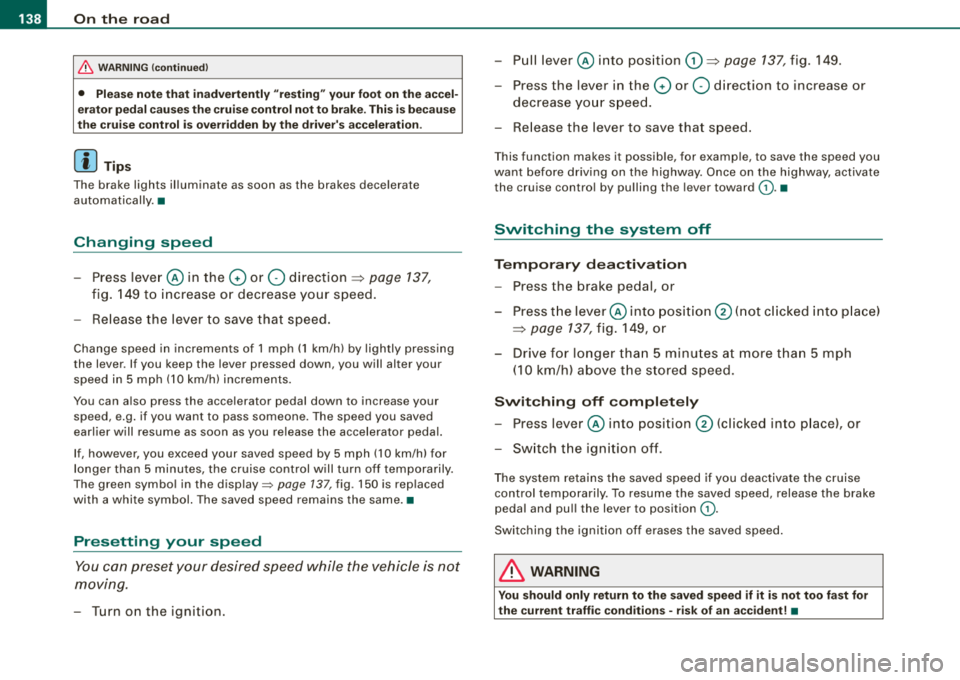
___ o_ n_ t_
h _e _ ro_ a_d __________________________________________________ _
&, WARNING (continued)
• Please note that inadvertently "resting" your foot on the accel
erator pedal causes the cruise control not to brake . This is because
the cruise control is overridden by the driver's acceleration.
[ i] Tips
The brake lights illumin ate as soon as the brakes decelerate
automatically. •
Changing speed
-Press lever@in the 0 or Q direction=> page 137,
fig. 149 to increase or decrease your speed.
-Release the lever to save that speed.
Change speed in increments of 1 mph (1 km/h) by lightly pressing
the lever . If you keep the lever pressed down, you will alter your
speed in 5 mph (10 km/h) increments.
You can also press the accelerator pedal down to increase your
speed, e.g. if you want to pass someone. The speed you saved
earlier will resume as soon as you release the accelerator pedal.
If, however, you exceed your saved speed by 5 mph (10 km/h) for
longer than 5 minutes, the cruise control will turn off temporarily.
The green symbol in the
display=> page 137, fig . 150 is replaced
with a white symbol. The saved speed remains the same. •
Presetting your speed
You can preset your desired speed while the vehicle is not
moving.
-Turn on the ignition .
-Pull lever@ into position G) => page 137, fig. 149 .
-Press the lever in the 0 or Q direction to increase or
decrease your speed.
-Release the lever to save that speed.
This function makes it possible, for example, to save the speed you
want before driving on the highway. Once on the highway, activate
the cruise contro l by pulling the lever toward
G). •
Switching the system off
Temporary deactivation
-Press the brake pedal, or
-Press the lever @into position ® (not clicked into place)
=> page 137, fig. 149, or
-Drive for longer than 5 minutes at more than 5 mph
(10 km/h) above the stored speed.
Switching off completely
-Press lever@ into position ® (clicked into place), or
-Switch the ignition off.
The system retains the saved speed if you deactivate the cruise
control temporarily . To resume the saved speed , release the brake
pedal and pull the lever to position
G) .
Switching the ignition off erases the saved speed.
& WARNING
You should only return to the saved speed if it is not too fast for
the current traffic conditions -risk of an accident!
•